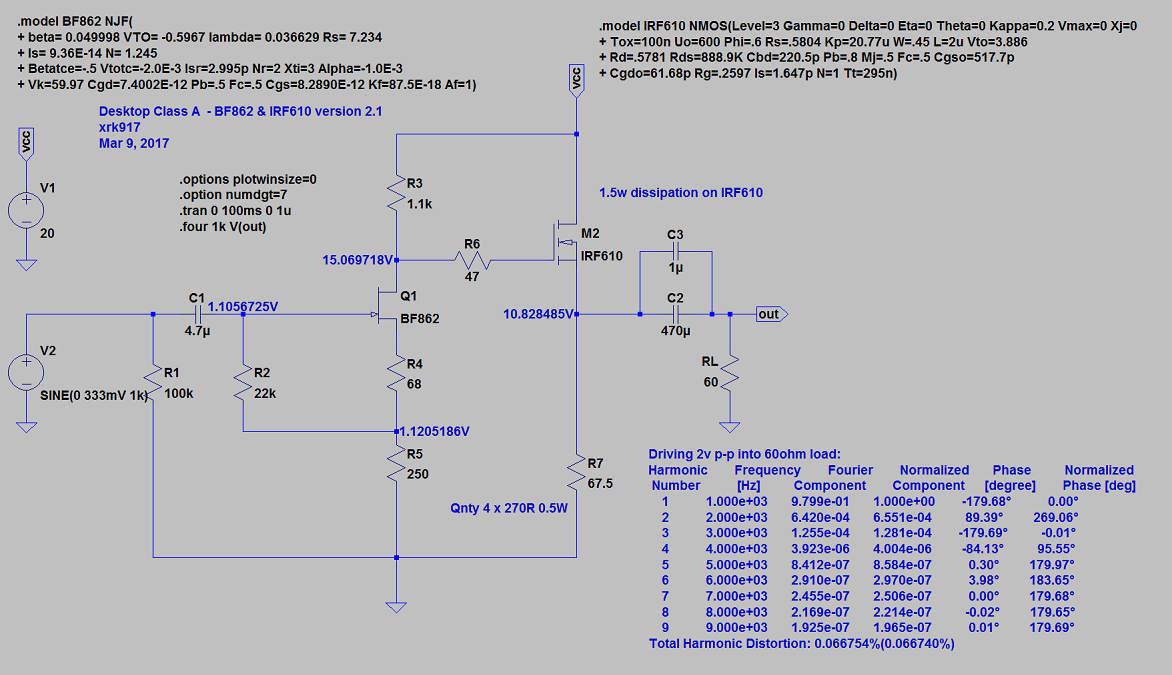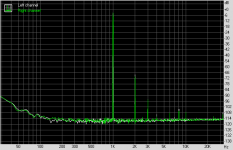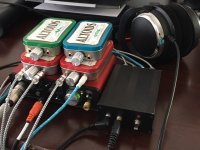IThis is a very simple circuit, so not much can be done. It is LUCK if we can find a JFET-MOS combo that will fit in this simple circuit with acceptable performance, especially by my standard. If damping is improved, THD will suffer.
BTW, can you post the model for the ZVN and the BF862? Who knows I will have time to play around with it.
The measured performance and subjective performance is quite outstanding, you might want to build it and listen before questioning whether or not the performance needs to be improved. This simple little Class A pocket amp is literally one of the top 2 amps in my 14 headamp stable of some pretty nice designs.
Code:
.SUBCKT ZVN4306 30 40 50
*NODES: DRAIN GATE SOURCE
M1 30 20 50 50 MOD1
RG 40 20 108
RL 30 50 6E6
D1 50 30 DIODE1
.MODEL MOD1 NMOS VTO=2.634 RS=0.2762 RD=0.0 IS=1E-15 KP=9.77
+CGSO=224.5E-12 CGDO=10.5E-12 CBD=405E-12 PB=1 LAMBDA=0
.MODEL DIODE1 D IS=6.19E-13 N=1.0043 RS=0.065
.ENDS ZVN4306
Code:
.model BF862 NJF(
+ beta= 0.049998 VTO= -0.5967 lambda= 0.036629 Rs= 7.234
+ Is= 9.36E-14 N= 1.245
+ Betatce=-.5 Vtotc=-2.0E-3 Isr=2.995p Nr=2 Xti=3 Alpha=-1.0E-3
+ Vk=59.97 Cgd=7.4002E-12 Pb=.5 Fc=.5 Cgs=8.2890E-12 Kf=87.5E-18 Af=1)For ZVN, right click on a generic NMOS fpr Component Attribute dialog box and enter "X" where it says "Prefix" and enter ZVN4306 in "Value Box"
Thanx for the models, X.
I have listened to your clips. My listening perception, especially of the weaknesses matches precisely with what is shown by simulation.
If you believe that all amps are effect boxes (they tend to have different flaws) then you will believe that good or very good, they all can be improved. And even after being improved, it will still far from perfect.
Like I said, in your circuit you have the common trade-off between damping and THD. If we talk about perfect amp, none of these 2 parameters are close to perfect. Those two parameters are only a few from many that human can perceive. And the strength of your amp is not any of the two, even tho it is hard to achieve low distortion like your design here with such a simple circuit). Each of us have different sensitivity to each of these parameters.
Simplest improvement to your circuit is by selecting by hand the FETs with highest beta (same FETs). Assuming that the key part is the ZVN, then higher beta JFET (like K170?) can be used (surrounding parts will change too of course) but the result is still unknown (because BF862 might be special).
If we want to improve damping without making THD suffers, we need to change the topology a bit. Cascading will principally lower THD so by sacrificing the THD back to the original circuit (e.g. 0.02%) we will have the chance to increase damping, running higher current to both JFET and MOSFET.
BTW, I don't have the parts and dont listen to headphone, so most possibly I will not build the circuit. But I might create one with different parts and for preamp. It cannot be the 2 transistor cct because I need lower THD than 0.02% in a preamp.
The measured performance and subjective performance is quite outstanding, you might want to build it and listen before questioning whether or not the performance needs to be improved.
I have listened to your clips. My listening perception, especially of the weaknesses matches precisely with what is shown by simulation.
If you believe that all amps are effect boxes (they tend to have different flaws) then you will believe that good or very good, they all can be improved. And even after being improved, it will still far from perfect.
Like I said, in your circuit you have the common trade-off between damping and THD. If we talk about perfect amp, none of these 2 parameters are close to perfect. Those two parameters are only a few from many that human can perceive. And the strength of your amp is not any of the two, even tho it is hard to achieve low distortion like your design here with such a simple circuit). Each of us have different sensitivity to each of these parameters.
Simplest improvement to your circuit is by selecting by hand the FETs with highest beta (same FETs). Assuming that the key part is the ZVN, then higher beta JFET (like K170?) can be used (surrounding parts will change too of course) but the result is still unknown (because BF862 might be special).
If we want to improve damping without making THD suffers, we need to change the topology a bit. Cascading will principally lower THD so by sacrificing the THD back to the original circuit (e.g. 0.02%) we will have the chance to increase damping, running higher current to both JFET and MOSFET.
BTW, I don't have the parts and dont listen to headphone, so most possibly I will not build the circuit. But I might create one with different parts and for preamp. It cannot be the 2 transistor cct because I need lower THD than 0.02% in a preamp.
\BTW, I don't have the parts and dont listen to headphone, so most possibly I will not build the circuit. But I might create one with different parts and for preamp. It cannot be the 2 transistor cct because I need lower THD than 0.02% in a preamp.
True, if looking for sub 0.02% THD one should look elsewhere, but a lower THD amp will not necessarily "sound" better. Note that in the case of AKSA's CFP using the venerable Toshiba 2SA1837, a THD level of 0.0056% was achieved. Probably result of a very good transistor, higher biasing in 125mA range, tight PCB layout, and a very good ultra-low ESR cap bank and cap Mx power supply.
but a lower THD amp will not necessarily "sound" better.
That's true. A perfect amp should have ALL numbers below thresholds. THD or whatever unknowns perceivable by ears. All headamps in this test for example have perceivable flaws like too high distortion, wrong timing, weak damping, etc.
Note that in the case of AKSA's CFP using the venerable Toshiba 2SA1837, a THD level of 0.0056% was achieved. Probably result of a very good transistor, higher biasing in 125mA range, tight PCB layout, and a very good ultra-low ESR cap bank and cap Mx power supply.
Yes, fast transistors (automatically low Cob too) will give us low THD, but it may be prone to instability that force us to add compensation. This compensation can affects phase which is often perceived as wrong timing etc. The driver and the transistor being driven should be a "match".
I think I have a good desktop amp here with IRF610 and BF862. Nice hot running 150mA bias and good ability to drive 60ohm cans.
http://www.diyaudio.com/forums/head...lass-headamp-without-heat-31.html#post5013830
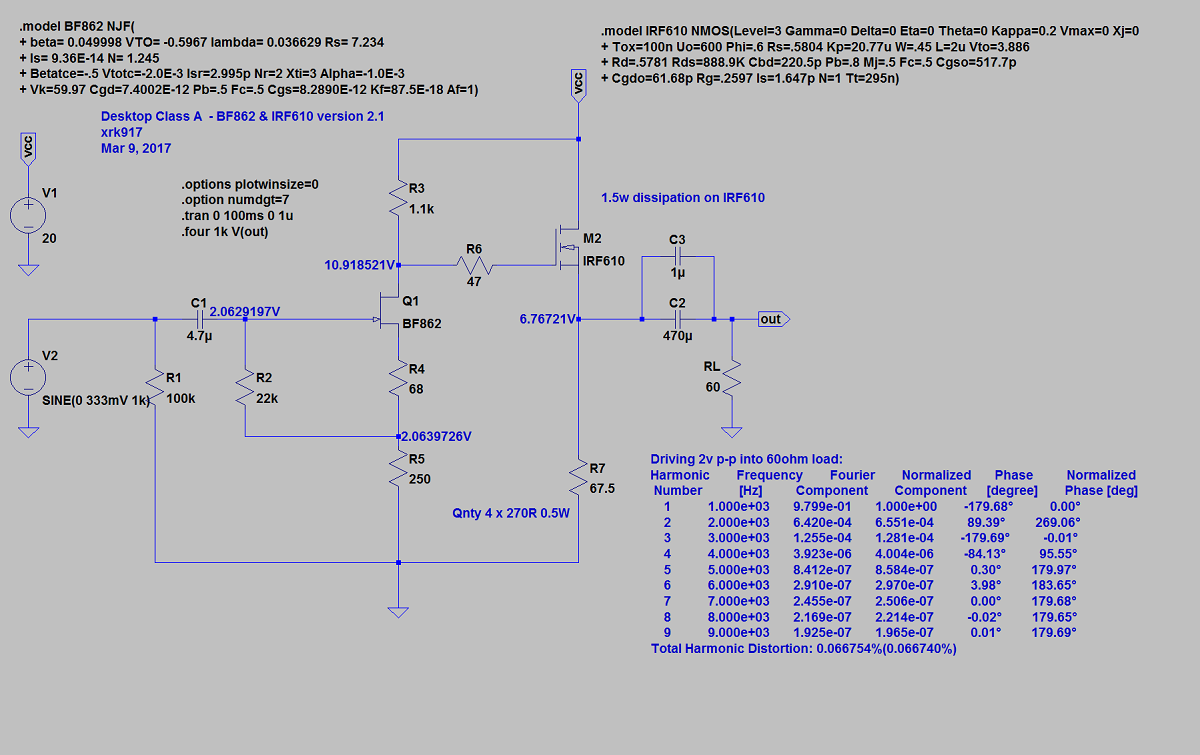
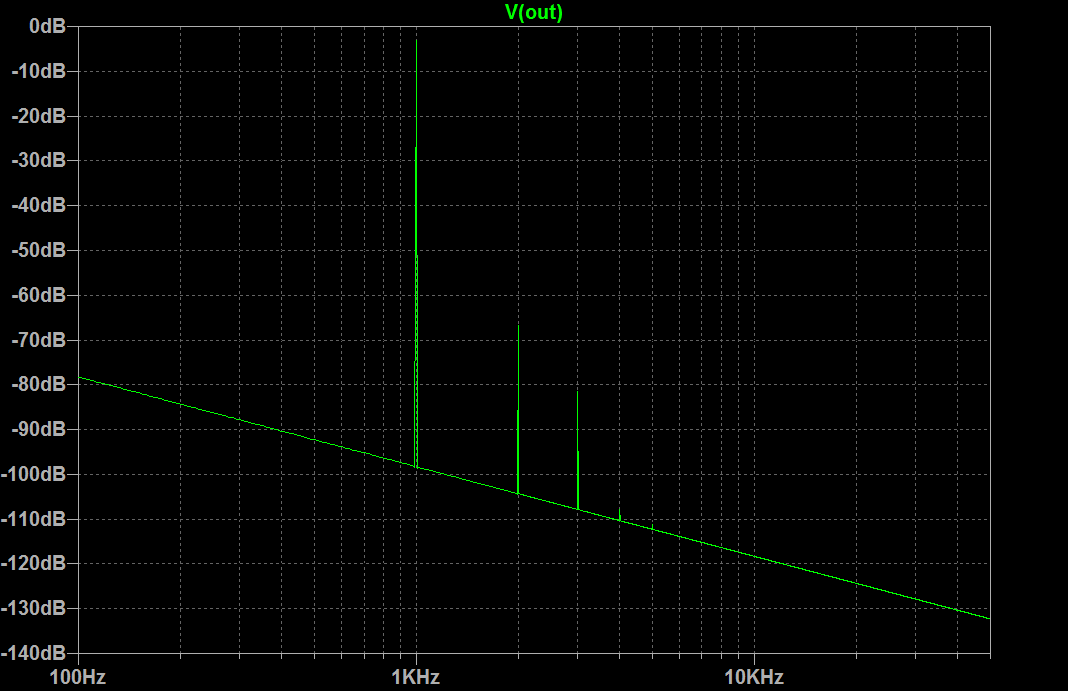
http://www.diyaudio.com/forums/head...lass-headamp-without-heat-31.html#post5013830


Last edited:
Here it is implemented using pocket Class A PCB. 140mA bias, 20v supply. Burning circa 3w per channel. These are temporary heatsinks. Way too small 🙂
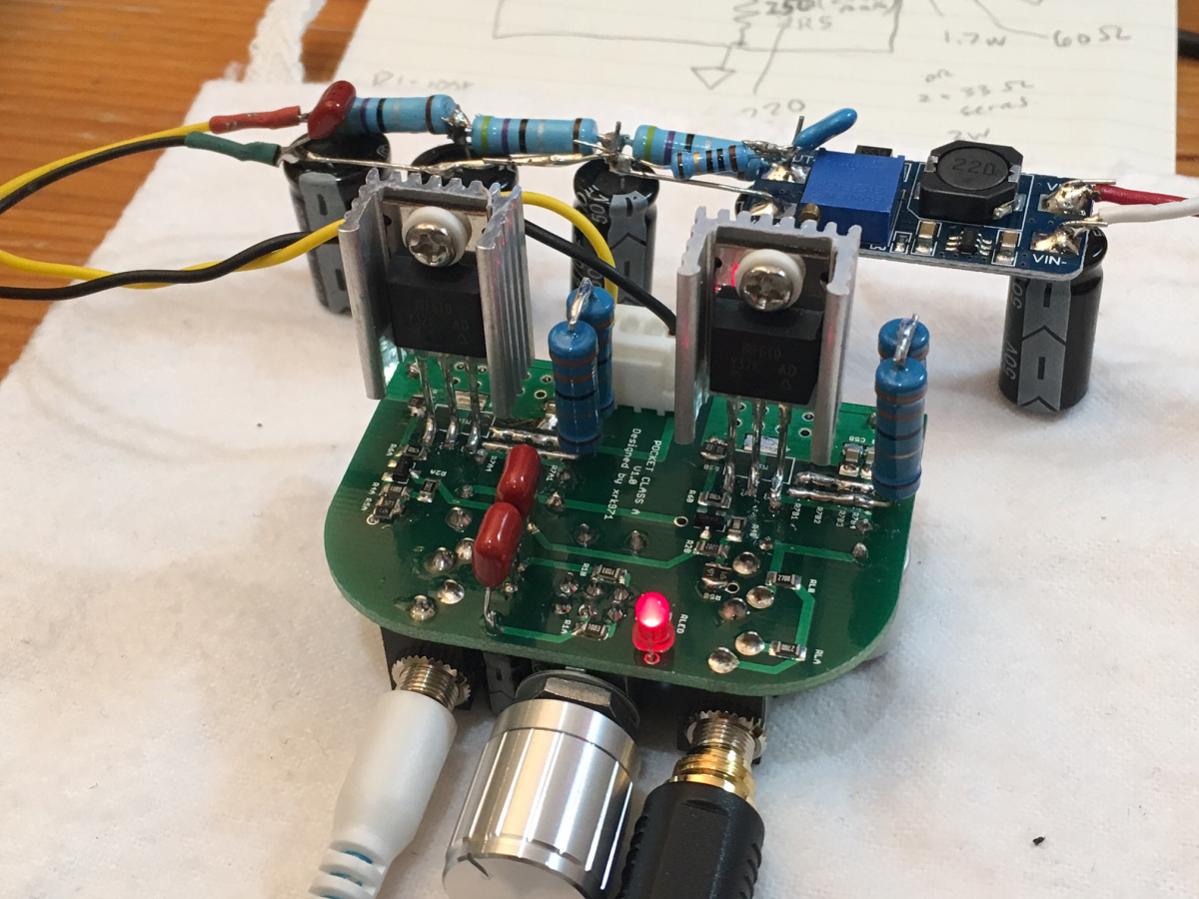

It sounds great - just like the pocket amp but desktop size. If I had lower impedance headhones I am sure there would be a more audible difference. Here is the new FFT wit power supply rail dropped to 16.5v. I just need to work on removing the broad low frequency noise now (inaudibe). Bias at 16.5v is 93mA. Local heatsinks almost big enough now.
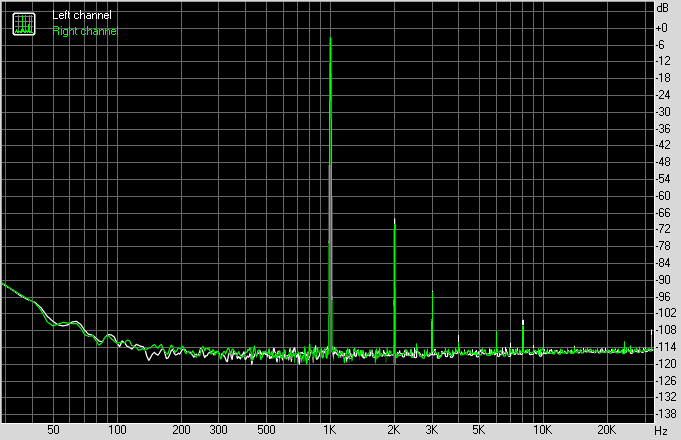

Attachments
Adding a larger CRC and cap bank seems to have fixed everything. Here is an AC mains powered amp with no shunt regs or cap multiplier - just SMPS and DC step up followed by CRCRCRC filtering that has -114dB noise floor with no ripple.
http://www.diyaudio.com/forums/head...lass-headamp-without-heat-34.html#post5015483
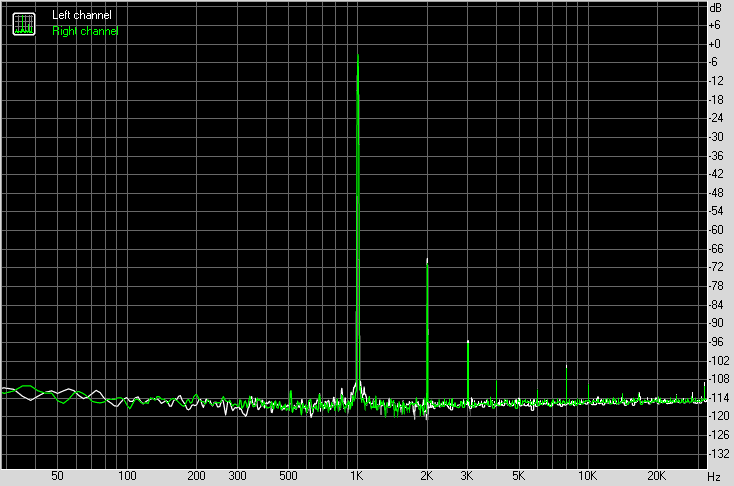
Listening to it now - much improved. Super dark darks and fantastic bass depth reaches low and holds you. Most of all, the presentation is now fully vivid and alive.
http://www.diyaudio.com/forums/head...lass-headamp-without-heat-34.html#post5015483

Listening to it now - much improved. Super dark darks and fantastic bass depth reaches low and holds you. Most of all, the presentation is now fully vivid and alive.
Last edited:
My latest Pocket Class A amp achieves same harmonic profile as desktop version using IRF610's and I have given it a desktop power jack. So no need to mske bigger desktop version unless you need larger 93mA bias for low impedance cans.
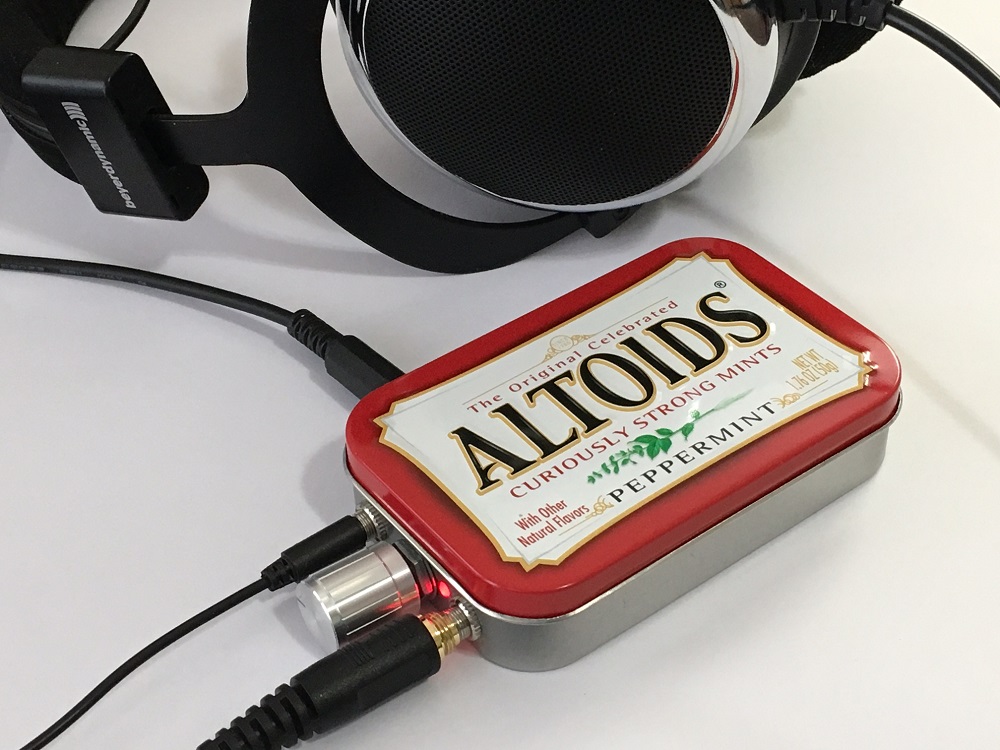
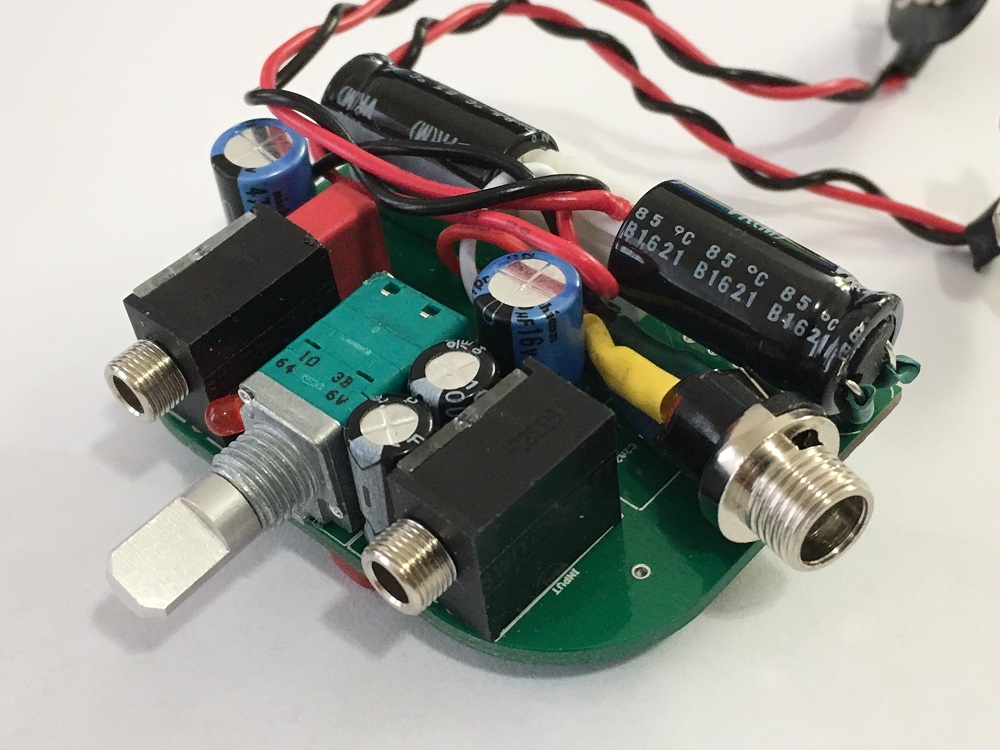
FFT:
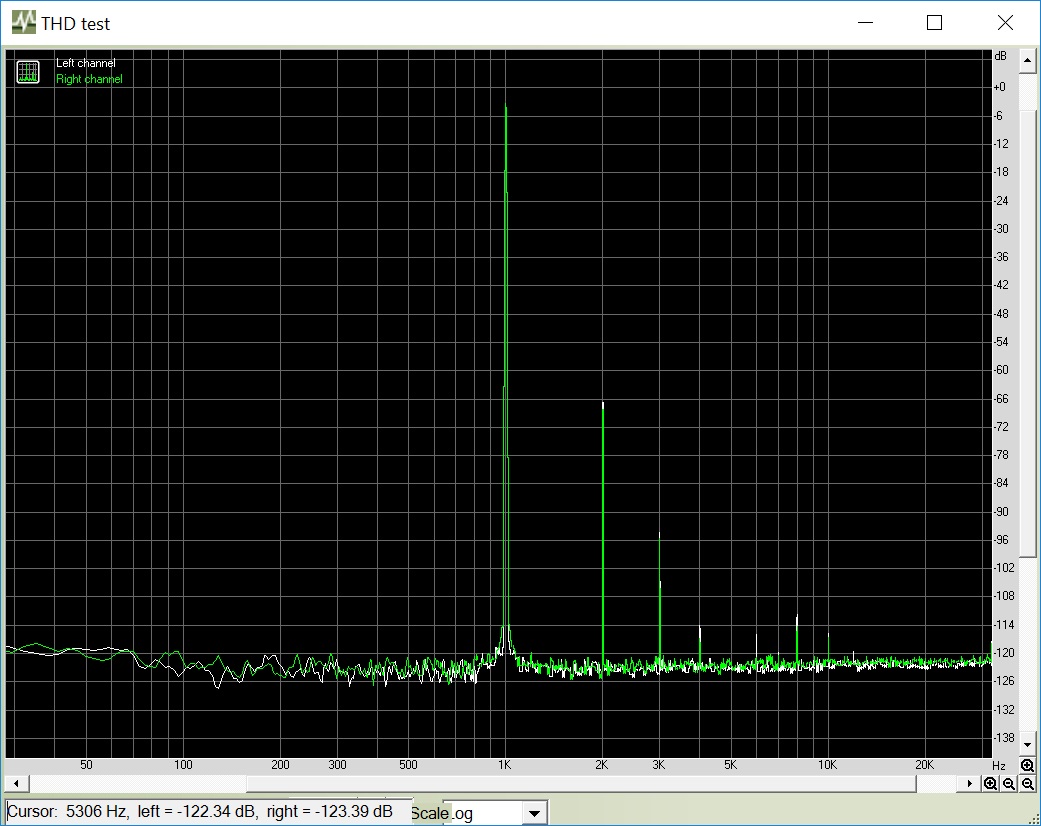


FFT:

AB Testing for QC
So many amps, so little time. This is how I test new amps to make sure they are up to snuff. An AB switcher box is really helpful to allow instantaneous switching so that if there are any differences - they can be heard easily. In this case I am using the AB box as quality control for a production item to ensure it sounds the same. Three Pocket Class A amps up for testing vs the standard known good reference.
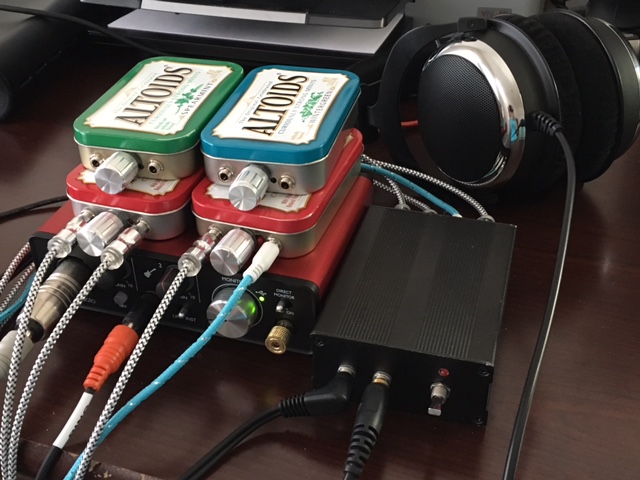
So many amps, so little time. This is how I test new amps to make sure they are up to snuff. An AB switcher box is really helpful to allow instantaneous switching so that if there are any differences - they can be heard easily. In this case I am using the AB box as quality control for a production item to ensure it sounds the same. Three Pocket Class A amps up for testing vs the standard known good reference.

Attachments
That A/B box would be so useful for tuning amps. How much did you spend on parts for that gizmo? It's essentially just jacks, wire, and a switch, right?
There's a 9v battery and switch that drives a $0.39 DC to DC step up to 12v. Two DPDT signal delays ($1 ea) and 6 x 3.5mm jacks. I used spring loaded momentary switch but you could do it regular. The case was the most expensive part at $7.
Here are the identities of the sound clips and their respective amps. Thank you to all that participated.
Although the sample size is very limited, so don't flame me - one thing I see is that two simple transistor amps is all that is needed for good sound with headphones. Ultralow distortion opamps aren't always the best sounding. Overall preference was for the BF862/2SA1837 CFP amp designed by AKSA. The fact that the amp uses the now discontinued, but legendary Toshiba 2SA1837 is no mistake. That is a good sounding transistor!
The Little Pocket Class A amp was not too shabby here either.
Headamp Comparison Key
A = BF862 Pre & DAO
B = CFP BF862-2SA1837
C = CFP BF862-BD140
D = DCG3
E = Fiio A5
F = Pocket Class A
G = SRPP 4 pair BF862
H = Super CMOY 1688
Here is the summary of the test data from the amps on the day the test was made:
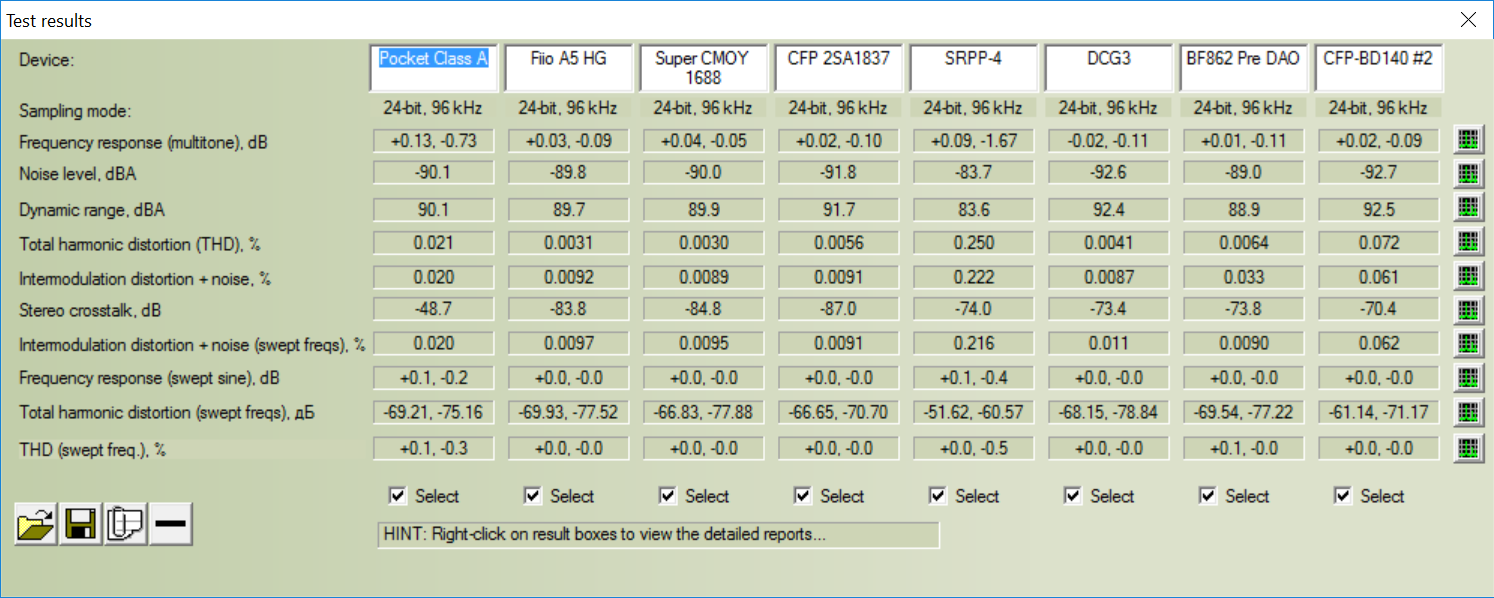
Note that the pocket class A has since been made into a real PCB with larger output caps and bigger rail caps so performance is even more improved (dynamic range is 94.2dB, stereo crosstalk is -72dB, noise floor is -126dB, freq response is +/-0.5dB 15Hz to 40kHz).
I do want to say that all these amps sound just great and I would be happy with them as daily listeners. However, given a choice, I will take my portable pocket class A amp any day. For sitting down and desktop amp listening, like many of you, I prefer the 2SA1837 CFP amp - it is my reference headphone amp. Now, if only one could squeeze the performance of the big 2SA1837 CFP onto a pocket amp to take with me... 🙂
This chart is fascinating to me. Do you have FFTs for each of these amps as well? It would be cool to be able to compare the amps by visualizing their distortion signatures. THD alone doesn't paint a very rich picture. I'd like to see FFTs of the Super CMOY and ASKA's CFP especially, but really I am curious about all of them. It may help others decide which amps they want to build too.
Yes I have the FFT's. I will post as soon as I get a chance. You will see that all of my (and Aksa's) Sae Class A amps here have a similar profile (basically set by the SE Class A topology) of having a predominant (about) 90% H2 at circa -66dB to -72dB and the balance of distortion coming in as H3 (about -20dB lower than H2) and then not much else. The noise floor on these amps is very low and flat also.
They will look sort of like the above:

They will look sort of like the above:

Last edited:
We are listening to the preamplifier of Focusrite, not the invidual amps. Should know how they react with real load. They sounded way too alike, but I preferred B. the harmonic layering was glorious. There was also some another maybe H or F that sounded more dynamic. B sounded open and realistic on vocals.
Well your source has to come from somewhere. And typically that source has a DAC and and opamp nowadays. But the poweramp that delivers the mW into the headphone certainly plays a role. Your choice of B was also the choice of most people. Followed by F - both SE Class A amps. B is now the preamp for my large Class AB speaker amps and it sounds glorious even with a Pass M2 Class A amp - which I did not care for the sound of before having the "B" preamp.
- Status
- Not open for further replies.
- Home
- Amplifiers
- Headphone Systems
- Blind Virtual Audition of Several Headamps
